South America
.svg.png) | |
| Area |
17,840,000 km2 (6,890,000 sq mi) |
|---|---|
| Population | 410,013,492 (2015, 5th) |
| Pop. density | 21.4/km2 (56.0/sq mi) |
| Demonym | South American |
| Countries | 12 |
| Dependencies | 3 |
| Languages | Portuguese, Spanish, English, French, Dutch, Quechua and many other native languages |
| Time zones | UTC-2 to UTC-5 |
| Largest cities |
List of cities in South America São Paulo Lima Bogotá Rio de Janeiro Santiago Caracas Buenos Aires Salvador Brasília Fortaleza Recife Belo Horizonte Medellín Valparaiso La Serena |
South America is a continent located in the western hemisphere, mostly in the southern hemisphere, with a relatively small portion in the northern hemisphere. It is also considered a subcontinent of the Americas,[1][2] which is the model used in nations that speak Romance languages. The reference to South America instead of other regions (like Latin America or the Southern Cone) has increased in the last decades due to changing geopolitical dynamics (in particular, the rise of Brazil).[3]
It is bordered on the west by the Pacific Ocean and on the north and east by the Atlantic Ocean; North America and the Caribbean Sea lie to the northwest. It includes twelve sovereign states (Argentina, Bolivia, Brazil, Chile, Colombia, Ecuador, Guyana, Paraguay, Peru, Suriname, Uruguay, and Venezuela), a part of France (French Guiana), and a non-sovereign area (the Falkland Islands, a British Overseas Territory though this is disputed by Argentina). In addition to this, the ABC islands of the Kingdom of the Netherlands, Trinidad and Tobago, and Panama may also be considered part of South America.
South America has an area of 17,840,000 square kilometers (6,890,000 sq mi). Its population as of 2005 has been estimated at more than 371,090,000. South America ranks fourth in area (after Asia, Africa, and North America) and fifth in population (after Asia, Africa, Europe, and North America). Brazil is by far the most populous South American country, with more than half of the continent's population, followed by Colombia, Argentina, Venezuela and Peru.[4] In recent decades Brazil has also concentrated half of the region's GDP and has become a first regional power.[3]
Most of the population lives near the continent's western or eastern coasts while the interior and the far south are sparsely populated. The geography of western South America is dominated by the Andes mountains; in contrast, the eastern part contains both highland regions and large lowlands where rivers such as the Amazon, Orinoco, and Paraná flow. Most of the continent lies in the tropics.
The continent's cultural and ethnic outlook has its origin with the interaction of indigenous peoples with European conquerors and immigrants and, more locally, with African slaves. Given a long history of colonialism, the overwhelming majority of South Americans speak Portuguese or Spanish, and societies and states commonly reflect Western traditions.
Geography
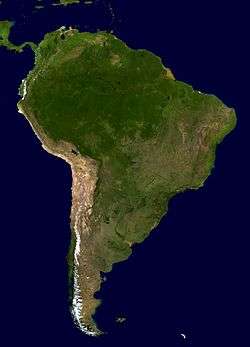

South America occupies the southern portion of the Americas. The continent is generally delimited on the northwest by the Darién watershed along the Colombia–Panama border, although some may consider the border instead to be the Panama Canal. Geopolitically and geographically[5] all of Panama – including the segment east of the Panama Canal in the isthmus – is typically included in North America alone[6][7][8] and among the countries of Central America.[9][10] Almost all of mainland South America sits on the South American Plate.
South America is home to the world's highest uninterrupted waterfall, Angel Falls in Venezuela; the highest single drop waterfall Kaieteur Falls in Guyana; the largest river (by volume), the Amazon River; the longest mountain range, the Andes (whose highest mountain is Aconcagua at 6,962 m [22,841 ft]); the driest non-polar place on earth, the Atacama Desert;[11][12][13] the largest rainforest, the Amazon Rainforest; the highest capital city, La Paz, Bolivia; the highest commercially navigable lake in the world, Lake Titicaca; and, excluding research stations in Antarctica, the world's southernmost permanently inhabited community, Puerto Toro, Chile.

.jpg)
South America's major mineral resources are gold, silver, copper, iron ore, tin, and petroleum. These resources found in South America have brought high income to its countries especially in times of war or of rapid economic growth by industrialized countries elsewhere. However, the concentration in producing one major export commodity often has hindered the development of diversified economies. The fluctuation in the price of commodities in the international markets has led historically to major highs and lows in the economies of South American states, often causing extreme political instability. This is leading to efforts to diversify production to drive away from staying as economies dedicated to one major export.
South America is one of the most biodiverse continents on earth. South America is home to many interesting and unique species of animals including the llama, anaconda, piranha, jaguar, vicuña, and tapir. The Amazon rainforests possess high biodiversity, containing a major proportion of the Earth's species.
Brazil is the largest country in South America, encompassing around half of the continent's land area and population. The remaining countries and territories are divided among three regions: The Andean States, the Guianas and the Southern Cone.
Outlying islands
Traditionally, South America also includes some of the nearby islands. Aruba, Bonaire, Curaçao, Trinidad, Tobago, and the federal dependencies of Venezuela sit on the northerly South American continental shelf and are often considered part of the continent. Geo-politically, the island states and overseas territories of the Caribbean are generally grouped as a part or subregion of North America, since they are more distant on the Caribbean Plate, even though San Andres and Providencia are politically part of Colombia and Aves Island is controlled by Venezuela.[8][14][15]
Other islands that are included with South America are the Galápagos Islands that belong to Ecuador and Easter Island (in Oceania but belonging to Chile), Robinson Crusoe Island, Chiloé (both Chilean) and Tierra del Fuego (split between Chile and Argentina). In the Atlantic, Brazil owns Fernando de Noronha, Trindade and Martim Vaz, and the Saint Peter and Saint Paul Archipelago, while the Falkland Islands are governed by the United Kingdom, whose sovereignty over the islands is disputed by Argentina. South Georgia and the South Sandwich Islands may be associated with either South America or Antarctica.
History
Prehistory

South America is believed to have been joined with Africa from the late Paleozoic Era to the early Mesozoic Era, until the supercontinent Pangaea began to rift and break apart about 225 million years ago. Therefore, South America and Africa share similar fossils and rock layers.
South America is thought to have been first inhabited by humans when people were crossing the Bering Land Bridge (now the Bering Strait) at least 15,000 years ago from the territory that is present-day Russia. They migrated south through North America, and eventually reached South America through the Isthmus of Panama.
The first evidence for the existence of the human race in South America dates back to about 9000 BC, when squashes, chili peppers and beans began to be cultivated for food in the highlands of the Amazon Basin. Pottery evidence further suggests that manioc, which remains a staple food today, was being cultivated as early as 2000 BC.[16]
By 2000 BC, many agrarian communities had been settled throughout the Andes and the surrounding regions. Fishing became a widespread practice along the coast, helping establish fish as a primary source of food. Irrigation systems were also developed at this time, which aided in the rise of an agrarian society.[16]
South American cultures began domesticating llamas, vicuñas, guanacos, and alpacas in the highlands of the Andes circa 3500 BC. Besides their use as sources of meat and wool, these animals were used for transportation of goods.[16]
Pre-Columbian civilizations

The rise of plant growing and the subsequent appearance of permanent human settlements allowed for the multiple and overlapping beginnings of civilizations in South America.
One of the earliest known South American civilizations was at Norte Chico, on the central Peruvian coast. Though a pre-ceramic culture, the monumental architecture of Norte Chico is contemporaneous with the pyramids of Ancient Egypt. Norte Chico governing class established a trade network and developed agriculture then followed by Chavín by 900 BC, according to some estimates and archaeological finds. Artifacts were found at a site called Chavín de Huantar in modern Peru at an elevation of 3,177 meters. Chavín civilization spanned 900 BC to 300 BC.
In the central coast of Peru, around the beginning of the 1st millennium AD, Moche (100 BC – 700 AD, at the northern coast of Peru), Paracas and Nazca (400 BC – 800 AD, Peru) cultures flourished with centralized states with permanent militia improving agriculture through irrigation and new styles of ceramic art. At the Altiplano, Tiahuanaco or Tiwanaku (100 BC – 1200 AD, Bolivia) managed a large commercial network based on religion.
Around 7th century, both Tiahuanaco and Wari or Huari Empire (600–1200, Central and northern Peru) expanded its influence to all the Andean region, imposing the Huari urbanism and tiahuanaco religious iconography.
The Muisca were the main indigenous civilization in what is now Colombia. They established the Muisca Confederation of many clans, or cacicazgos, that had a free trade network among themselves. They were goldsmiths and farmers.
Other important Pre-Columbian cultures include: the Cañaris (in south central Ecuador), Chimú Empire (1300–1470, Peruvian northern coast), Chachapoyas, and the Aymaran kingdoms (1000–1450, Western Bolivia and southern Peru).
Holding their capital at the great city of Cusco, the Inca civilization dominated the Andes region from 1438 to 1533. Known as Tawantin suyu, and "the land of the four regions," in Quechua, the Inca civilization was highly distinct and developed. Inca rule extended to nearly a hundred linguistic or ethnic communities, some 9 to 14 million people connected by a 25,000 kilometer road system. Cities were built with precise, unmatched stonework, constructed over many levels of mountain terrain. Terrace farming was a useful form of agriculture.
The Mapuche in Central and Southern Chile resisted the European and Chilean settlers, waging the Arauco War for more than 300 years.
European colonization
.jpg)
In 1494, Portugal and Spain, the two great maritime European powers of that time, on the expectation of new lands being discovered in the west, signed the Treaty of Tordesillas, by which they agreed, with the support of the Pope, that all the land outside Europe should be an exclusive duopoly between the two countries.
The treaty established an imaginary line along a north-south meridian 370 leagues west of the Cape Verde Islands, roughly 46° 37' W. In terms of the treaty, all land to the west of the line (known to comprise most of the South American soil) would belong to Spain, and all land to the east, to Portugal. As accurate measurements of longitude were impossible at that time, the line was not strictly enforced, resulting in a Portuguese expansion of Brazil across the meridian.
Beginning in the 1530s, the people and natural resources of South America were repeatedly exploited by foreign conquistadors, first from Spain and later from Portugal. These competing colonial nations claimed the land and resources as their own and divided it in colonies.
European infectious diseases (smallpox, influenza, measles, and typhus) – to which the native populations had no immune resistance – caused large-scale depopulation of the native population under Spanish control. Systems of forced labor, such as the haciendas and mining industry's mit'a also contributed to the depopulation. After this, African slaves, who had developed immunities to these diseases, were quickly brought in to replace them.
The Spaniards were committed to convert their native subjects to Christianity and were quick to purge any native cultural practices that hindered this end; however, many initial attempts at this were only partially successful, as native groups simply blended Catholicism with their established beliefs and practices. Furthermore, the Spaniards brought their language to the degree they did with their religion, although the Roman Catholic Church's evangelization in Quechua, Aymara, and Guaraní actually contributed to the continuous use of these native languages albeit only in the oral form.
Eventually, the natives and the Spaniards interbred, forming a mestizo class. At the beginning, many mestizos of the Andean region were offspring of Amerindian mothers and Spanish fathers. After independence, most mestizos had native fathers and European or mestizo mothers.
Many native artworks were considered pagan idols and destroyed by Spanish explorers; this included many gold and silver sculptures and other artifacts found in South America, which were melted down before their transport to Spain or Portugal. Spaniards and Portuguese brought the western European architectural style to the continent, and helped to improve infrastructures like bridges, roads, and the sewer system of the cities they discovered or conquered. They also significantly increased economic and trade relations, not just between the old and new world but between the different South American regions and peoples. Finally, with the expansion of the Portuguese and Spanish languages, many cultures that were previously separated became united through that of Latin American.
Guyana was first a Dutch, and then a British colony, though there was a brief period during the Napoleonic Wars when it was colonized by the French. The country was once partitioned into three parts, each being controlled by one of the colonial powers until the country was finally taken over fully by the British.
Slavery in Pre-Modern Latin America
Indigenous peoples of the Americas in various European colonies were forced to work in European plantations and mines; along with African slaves who were also introduced in the proceeding centuries.
Independence from Spain and Portugal
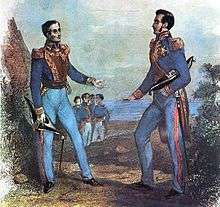
The European Peninsular War (1807–1814), a theater of the Napoleonic Wars, changed the political situation of both the Spanish and Portuguese colonies. First, Napoleon invaded Portugal, but the House of Braganza avoided capture by escaping to Brazil. Napoleon also captured King Ferdinand VII of Spain, and appointed his own brother instead. This appointment provoked severe popular resistance, which created Juntas to rule in the name of the captured king.
Many cities in the Spanish colonies, however, considered themselves equally authorized to appoint local Juntas like those of Spain. This began the Spanish American wars of independence between the patriots, who promoted such autonomy, and the royalists, who supported Spanish authority over the Americas. The Juntas, in both Spain and the Americas, promoted the ideas of the Enlightenment. Five years after the beginning of the war, Ferdinand VII returned to the throne and began the Absolutist Restoration as the royalists got the upper hand in the conflict.
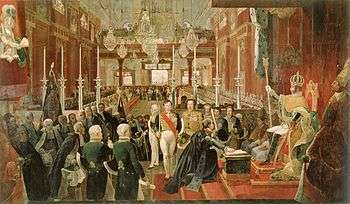
The independence of South America was secured by Simón Bolívar (Venezuela) and José de San Martín (Argentina), the two most important Libertadores. Bolívar led a great uprising in the north, then led his army southward towards Lima, the capital of the Viceroyalty of Peru. Meanwhile, San Martín led an army across the Andes Mountains, along with Chilean expatriates, and liberated Chile. He organized a fleet to reach Peru by sea, and sought the military support of various rebels from the Viceroyalty of Peru. The two armies finally met in Guayaquil, Ecuador, where they cornered the Royal Army of the Spanish Crown and forced its surrender.
In the Portuguese Kingdom of Brazil, Dom Pedro I (also Pedro IV of Portugal), son of the Portuguese King Dom João VI, proclaimed the independent Kingdom of Brazil in 1822, which later became the Empire of Brazil. Despite the Portuguese loyalties of garrisons in Bahia, Cisplatina and Pará, independence was diplomatically accepted by the crown in Portugal, on condition of a high compensation paid by Brazil.
Nation-building and balkanization
The newly independent nations began a process of balkanization, with several civil and international wars. However, it was not as strong as in Central America. Some countries created from provinces of larger countries stayed as such up to modern day (such as Paraguay or Uruguay), while others were reconquered and reincorporated into their former countries (such as the Republic of Entre Ríos and the Riograndense Republic).
The Peru–Bolivian Confederation, a short-lived union of Peru and Bolivia, was blocked by Chile in the War of the Confederation (1836–1839) and again during the War of the Pacific (1879–1883). Paraguay was virtually destroyed by Argentina and Brazil in the Paraguayan War.
Rise and fall of military dictatorships

Wars became less frequent in the 20th century, with Bolivia-Paraguay and Peru-Ecuador fighting the last inter-state wars. Early in the 20th century, the three wealthiest South American countries engaged in a vastly expensive naval arms race which was catalyzed by the introduction of a new warship type, the "dreadnought". At one point, the Argentine government was spending a fifth of its entire yearly budget for just two dreadnoughts, a price that did not include later in-service costs, which for the Brazilian dreadnoughts was sixty percent of the initial purchase.[18][19]
The continent became a battlefield of the Cold War in the late 20th century. Some democratically elected governments of Argentina, Brazil, Chile, Uruguay and Paraguay were overthrown or displaced by military dictatorships in the 1960s and 1970s. To curtail opposition, their governments detained tens of thousands of political prisoners, many of whom were tortured and/or killed on inter-state collaboration. Economically, they began a transition to neoliberal economic policies. They placed their own actions within the US Cold War doctrine of "National Security" against internal subversion. Throughout the 1980s and 1990s, Peru suffered from an internal conflict.
Argentina and Britain fought the Falklands War in 1982.
Colombia has had an ongoing, though diminished internal conflict, which started in 1964 with the creation of Marxist guerrillas (FARC-EP) and then involved several illegal armed groups of leftist-leaning ideology as well as the private armies of powerful drug lords. Many of these are now defunct, and only a small portion of the ELN remains, along with the stronger, though also greatly reduced FARC. These leftist groups smuggle narcotics out of Colombia to fund their operations, while also using kidnapping, bombings, land mines and assassinations as weapons against both elected and non-elected citizens.
.jpg)
Revolutionary movements and right-wing military dictatorships became common after World War II, but since the 1980s, a wave of democratization came through the continent, and democratic rule is widespread now.[20] Nonetheless, allegations of corruption are still very common, and several countries have developed crises which have forced the resignation of their governments, although, in most occasions, regular civilian succession has continued.
International indebtedness turned into a severe problem in late 1980s, and some countries, despite having strong democracies, have not yet developed political institutions capable of handling such crises without resorting to unorthodox economic policies, as most recently illustrated by Argentina's default in the early 21st century.[21] The last twenty years have seen an increased push towards regional integration, with the creation of uniquely South American institutions such as the Andean Community, Mercosur and Unasur. Notably, starting with the election of Hugo Chávez in Venezuela in 1998, the region experienced what has been termed a pink tide – the election of several leftist and center-left administrations to most countries of the area, except for the Guianas and Colombia.
Countries and territories
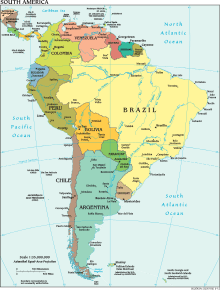


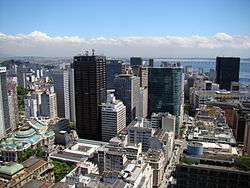
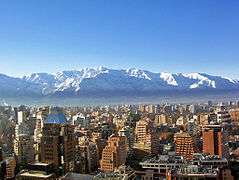
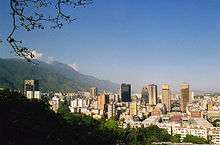

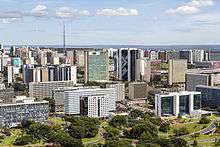
.jpg)
| Arms | Flag | Country or territory with flag |
Area (km²)[22] (sq mi) |
Population (July 2009 est.)[22] |
Population density per km2 (per sq mi) |
Capital |
|---|---|---|---|---|---|---|
| |
|
Argentina | 2,766,890 km2 (1,068,300 sq mi) | 40,482,000 | 14.3/km² (37/sq mi) | Buenos Aires |
| |
|
Bolivia | 1,098,580 km2 (424,160 sq mi) | 9,863,000 | 8.4/km² (21.8/sq mi) | La Paz and Sucre[23] |
| |
|
Brazil | 8,514,877 km2 (3,287,612 sq mi) | 202,241,714 | 22.0/km² (57/sq mi) | Brasília |
| |
|
Chile[24] | 756,950 km2 (292,260 sq mi) | 16,928,873 | 22/km² (57/sq mi) | Santiago |
| |
|
Colombia | 1,141,748 km2 (440,831 sq mi) | 46,920,000 | 40/km² (103.6/sq mi) | Bogotá |
| |
|
Ecuador | 283,560 km2 (109,480 sq mi) | 14,573,101 | 53.8/km² (139.3/sq mi) | Quito |
| |
|
Falkland Islands (United Kingdom)[25] | 12,173 km2 (4,700 sq mi) | 3,140[26] | 0.26/km² (0.7/sq mi) | Stanley |
| |
|
French Guiana (France) | 91,000 km2 (35,000 sq mi) | 221,500[27] | 2.7/km² (5.4/sq mi) | Cayenne (Préfecture) |
| |
|
Guyana | 214,999 km2 (83,012 sq mi) | 772,298 | 3.5/km² (9.1/sq mi) | Georgetown |
| |
|
Paraguay | 406,750 km2 (157,050 sq mi) | 6,831,306 | 15.6/km² (40.4/sq mi) | Asunción |
| |
|
Peru | 1,285,220 km2 (496,230 sq mi) | 29,132,013 | 22/km² (57/sq mi) | Lima |
| |
|
South Georgia and the South Sandwich Islands (United Kingdom)[28] | 3,093 km2 (1,194 sq mi) | 20 | 0/km² (0/sq mi) | King Edward Point[29] |
| |
|
Suriname | 163,270 km2 (63,040 sq mi) | 472,000 | 3/km² (7.8/sq mi) | Paramaribo |
| |
|
Uruguay | 176,220 km2 (68,040 sq mi) | 3,477,780 | 19.4/km² (50.2/sq mi) | Montevideo |
| |
|
Venezuela | 916,445 km2 (353,841 sq mi) | 31,648,930 | 30.2/km² (72/sq mi) | Caracas |
| Total | 17,824,513 | 385,742,554 | 21.5/km² | |||
Politics
During the first decade of the 21st century, South American governments have drifted to the political left, with leftist leaders being elected in Chile, Uruguay, Brazil, Argentina, Ecuador, Bolivia, Paraguay, Peru and Venezuela. Most South American countries are making an increasing use of protectionist policies, helping local development.
Recently, an intergovernmental entity has been formed which aims to merge the two existing customs unions: Mercosur and the Andean Community, thus forming the third-largest trade bloc in the world.[30] This new political organization known as Union of South American Nations seeks to establish free movement of people, economic development, a common defense policy and the elimination of tariffs.
Ethnic demographics
Genetic studies
Genetic admixture occurs at very high levels in South America. In Argentina the European influence accounts for 65%–79% of the genetic background, 17%–31% of the Amerindian and 2%–4% of sub-Saharan African. In Colombia the European genetic background varied from 46% to 79% depending on the region. In Peru European ancestries ranged from 1% to 31%, while the African contribution was only 1% to 3%.[31] The Genographic Project determined the average Peruvian from Lima had about 28% of European ancestry, 68% of native American and 2% of sub-Saharan Africa.[32]
Ethnic groups
Descendants of indigenous peoples, such as the Quechua and Aymara, or the Urarina[33] of Amazonia make up the majority of the population in Bolivia (56%) and, per some sources, in Peru (44%).[34][35] In Ecuador, Amerindians are a large minority that comprises two-fifths of the population. The native European population is also a significant element in most other former Portuguese colonies.
South America is also home to one of the largest populations of Africans. This group is also significantly present in Guyana, Brazil, Colombia, Suriname, French Guiana, and Ecuador. Mestizos (mixed European and Amerindian) are the largest ethnic group in Paraguay, Venezuela, Colombia (49%)[36] and Ecuador and the second group in Peru. East Indians form the largest ethnic group in Guyana and Suriname. Brazil followed by Peru also have the largest Japanese, Korean and Chinese communities in South America.[37]
The demographics of Colombia include approximately 37% native European descendants,[36][38] while in Peru, European descendants are the third group in importance (15%).[39] Compared to other South American countries, the people who identify as of primarily or totally European descent, or identify their phenotype as corresponding to such group, are more of a majority in Argentina,[40] Chile[41][42] and Uruguay,[41] and are about half of the population of Brazil.[43][44][45] In Venezuela, according to the national census 42% of the population is primarily native Spanish, Italian and Portuguese descendants.[46]
Indigenous people
In many places indigenous people still practice a traditional lifestyle based on subsistence agriculture or as hunter-gatherers. There are still some uncontacted tribes residing in the Amazon Rainforest.[47]
- Aguarunas
- Alacalufe
- Arawaks
- Ashanincas
- Atacameños
- Awá
- Aymara – lives in the Altiplano of Bolivia, Argentina, Chile and Peru. Their language is co-official in Peru and Bolivia. Traditional lifestyle includes llama herding.
- Banawa
- Cañaris
- Caiapos
- Chibcha
- Cocama
- Chayahuita
- Kuna live on the Colombia-Panama border.
- Enxet
- Gê,
- Guaraní – lives in Paraguay where the Guarani language is co-official with Spanish.
- Juris
- Mapuche – lives mainly in southern Chile and Argentina.
- Matsés
- Pehuenche – a branch of Mapuches that lived in the Andean valleys of southern (see Araucanian).
- Quechuas – makes up a large part of the population of Peru, Ecuador and Bolivia. Are diverse as an ethnic group. The Incas spoke Southern Quechua.
- Selknam
- Shipibo
- Shuar (see Jivaro).
- Tupi
- Urarina
- Wai-Wai
- Wayuu
- Xucuru
- Yaghan
- Yagua
- Yąnomamö
- Zaparos
Economy

South America relies less on the export of both manufactured goods and natural resources than the world average; merchandise exports from the continent were 16% of GDP on an exchange rate basis, compared to 25% for the world as a whole.[48] Brazil (the seventh largest economy in the world and the largest in South America) leads in terms of merchandise exports at $251 billion, followed by Venezuela at $93 billion, Chile at $86 billion, and Argentina at $84 billion.[48]
The economic gap between the rich and poor in most South American nations is larger than in most other continents. The richest 10% receive over 40% of the nation's income in Bolivia, Brazil, Chile, Colombia, and Paraguay,[49] while the poorest 20% receive 3% or less in Bolivia, Brazil, and Colombia.[50] This wide gap can be seen in many large South American cities where makeshift shacks and slums lie in the vicinity of skyscrapers and upper-class luxury apartments; nearly one in nine in South America live on less than $2 per day (on a purchasing power parity basis).[51]
| Country | GDP (nominal) in 2014[52] |
GDP (PPP) in 2014[52] |
GDP (PPP) per capita in 2011[52] |
Merchandise exports ($bn), 2011[48] |
HDI in 2011 (rank)[53] |
Percent with less than $2 (PPP) per person per day[51] |
|---|---|---|---|---|---|---|
| |
536,155 | 927,382 | 17,516 | 83.7 | 0.797 | 2.6 |
| |
34,083 | 69,979 | 4,789 | 9.1 | 0.663 | 24.9 |
| |
2,244,131 | 3,072,607 | 11,769 | 250.8 | 0.744 | 10.8 |
| |
264,095 | 410,277 | 17,222 | 86.1 | 0.805 | 2.7 |
| |
400,117 | 641,532 | 10,249 | 56.5 | 0.710 | 15.8 |
| |
100,485 | 181,950 | 8,492 | 22.3 | 0.720 | 10.6 |
| |
165 | 165 | 55,400 | 0.1 | ||
| |
4,456 | 4,456 | 19,728 | 1.3 | ||
| |
3,142 | 5,498 | 7,465 | 0.9 | 0.633 | 18.0 |
| |
31,301 | 57,866 | 5,413 | 9.8 | 0.665 | 13.2 |
| |
208,188 | 376,736 | 10,062 | 46.3 | 0.725 | 12.7 |
| |
5,273 | 9,240 | 9,475 | 1.6 | 0.680 | 27.2 |
| |
55,597 | 69,777 | 15,113 | 8.0 | 0.783 | 2.2 |
| |
209,226 | 545,704 | 12,568 | 92.6 | 0.735 | 12.9 |
| Total | 4,176,712 | 4,738,384 | 11,962 | 669.1 | 0.729 | 11.3 |
Economically largest cities 2010
| Rank | City | Country | GDP in Int$ bn[56] | Population (mil)[57] | GDP per capita |
|---|---|---|---|---|---|
| 1 | São Paulo | |
$458 | 20,186,000 | $19,221 |
| 2 | Buenos Aires | |
$362 | 13,639,000 | $26,542 |
| 3 | Rio de Janeiro | |
$201 | 12,043,000 | $16,690 |
| 4 | Bogotá | |
$140 | 12,218,062 | $15,891 |
| 5 | Santiago | |
$120 | 6,015,000 | $19,950 |
| 6 | Brasília | |
$110 | 2,362,000 | $46,571 |
| 7 | Lima | |
$109 | 9,121,000 | $11,950 |
| 8 | Caracas | |
$99 | 5,965,000 | $15,646 |
| 9 | Belo Horizonte | |
$61 | 5,523,000 | $11,045 |
| 10 | Medellín | |
$50 | 3,686,000 | $13,565 |

Tourism
Tourism has increasingly become a significant source of income for many South American countries.[58][59] Historical relics, architectural and natural wonders, a diverse range of foods and culture, vibrant and colorful cities, and stunning landscapes attract millions of tourists every year to South America. Some of the most visited places in the region are Iguazu Falls, Recife, Olinda, Machu Picchu, the Amazon rainforest, Rio de Janeiro, Salvador, Fortaleza, Maceió, Buenos Aires, Florianópolis, San Ignacio Miní, Isla Margarita, Natal, Lima, São Paulo, Angel Falls, Brasília, Nazca Lines, Perito Moreno Glacier, Cuzco, Belo Horizonte, Lake Titicaca, Salar de Uyuni, Jesuit Missions of Chiquitos, Los Roques archipelago, Bogotá, Patagonia, Gran Sabana, Cartagena, and the Galápagos Islands.[60][61]
In 2016 Brazil hosted the 2016 Summer Olympics.

Culture

South Americans are culturally influenced by their indigenous peoples, the historic connection with the Iberian Peninsula and Africa, and waves of immigrants from around the globe.
South American nations have a rich variety of music. Some of the most famous genres include vallenato and cumbia from Colombia, pasillo from Ecuador, samba, bossa nova and música sertaneja from Brazil, and tango from Argentina and Uruguay. Also well known is the non-commercial folk genre Nueva Canción movement which was founded in Argentina and Chile and quickly spread to the rest of the Latin America. People on the Peruvian coast created the fine guitar and cajon duos or trios in the most mestizo (mixed) of South American rhythms such as the Marinera (from Lima), the Tondero (from Piura), the 19th century popular Creole Valse or Peruvian Valse, the soulful Arequipan Yaravi, and the early 20th century Paraguayan Guarania. In the late 20th century, Spanish rock emerged by young hipsters influenced by British pop and American rock. Brazil has a Portuguese-language pop rock industry as well a great variety of other music genres.
The literature of South America has attracted considerable critical and popular acclaim, especially with the Latin American Boom of the 1960s and 1970s, and the rise of authors such as Mario Vargas Llosa, Gabriel García Márquez in novels and Jorge Luis Borges and Pablo Neruda in other genres. The Brazilians Machado de Assis and João Guimarães Rosa are widely regarded as the greatest Brazilian writers.
Because of South America's broad ethnic mix, South American cuisine has African, South American Indian, Asian, and European influences. Bahia, Brazil, is especially well known for its West African–influenced cuisine. Argentines, Chileans, Uruguayans, Brazilians, Bolivians, and Venezuelans regularly consume wine. Argentina, Paraguay, Uruguay, and people in southern Chile, Bolivia and Brazil drink mate, a herb which is brewed. The Paraguayan version, terere, differs from other forms of mate in that it is served cold. Pisco is a liquor distilled from grapes in Peru and Chile. Peruvian cuisine mixes elements from Chinese, Japanese, Spanish, Italian, African, Arab, Andean, and Amazonic food.
Language
.svg.png)
Spanish and Portuguese are the most spoken languages in South America, with approximately 200 million speakers each. Spanish is the official language of most countries, along with other native languages in some countries. Portuguese is the official language of Brazil. Dutch is the official language of Suriname; English is the official language of Guyana, although there are at least twelve other languages spoken in the country, including Portuguese, Chinese, Hindustani and several native languages.[62] English is also spoken in the Falkland Islands. French is the official language of French Guiana and the second language in Amapá, Brazil.
Indigenous languages of South America include Quechua in Ecuador, Peru, Chile, Colombia, and Bolivia; Wayuunaiki in northern Colombia (La Guajira) and northwestern Venezuela (Zulia); Guaraní in Paraguay and, to a much lesser extent, in Bolivia; Aymara in Bolivia, Peru, and less often in Chile; and Mapudungun is spoken in certain pockets of southern Chile and, more rarely, Argentina. At least three South American indigenous languages (Quechua, Aymara, and Guarani) are recognized along with Spanish as national languages.
Other languages found in South America include, Hindustani and Javanese in Suriname; Italian in Argentina, Brazil, Uruguay, Venezuela and Chile; and German in certain pockets of Argentina, Brazil, and Chile. German is also spoken in many regions of the southern states of Brazil, Riograndenser Hunsrückisch being the most widely spoken German dialect in the country; among other Germanic dialects, a Brazilian form of Pomeranian is also well represented and is experiencing a revival. Welsh remains spoken and written in the historic towns of Trelew and Rawson in the Argentine Patagonia. There are also small clusters of Japanese-speakers in Brazil, Colombia and Peru. Arabic speakers, often of Lebanese, Syrian, or Palestinian descent, can be found in Arab communities in Argentina, Colombia, Brazil, Venezuela and in Paraguay.[63]
Sport
A wide range of sports are played in the continent of South America, with football being the most popular overall, while baseball is the most popular in Venezuela.
Other sports include basketball, cycling, polo, volleyball, futsal, motorsports, rugby (mostly in Argentina and Uruguay), handball, tennis, golf, field hockey and boxing.
South America hosted its first Olympic Games in Rio de Janeiro, Brazil in 2016 and will host the Youth Olympic Games in Buenos Aires, Argentina in 2018.
.jpg)
South America shares with Europe the supremacy over the sport of football as all winners in FIFA World Cup history and all winning teams in the FIFA Club World Cup have come from these two continents. Brazil holds the record at the FIFA World Cup with five titles in total. Argentina and Uruguay have two titles each. So far four South American nations have hosted the tournament including the first edition in Uruguay (1930). The other three were Brazil (1950, 2014), Chile (1962), and Argentina (1978).
South America is home to the longest running international football tournament; the Copa América, which has been regularly contested since 1916. Uruguay have won the Copa América a record 15 times, surpassing hosts Argentina in 2011 to reach 15 titles (they were previously equal on 14 titles each during the 2011 Copa América). The continent has produced many of the most famous and most talented players including Diego Maradona, Pelé, Alfredo Di Stéfano, Lionel Messi, Ronaldo, Ronaldinho, Rivaldo, Teófilo Cubillas, Mario Kempes, Gabriel Batistuta, César Cueto, Enzo Francescoli, Arsenio Erico, Alberto Spencer, Carlos Valderrama, Elias Figueroa, Marcelo Salas, Juan Arango, Neymar, and Luis Suárez.
Also, in South America, a multi-sport event, the South American Games, are held every four years. The first edition was held in La Paz in 1978 and the most recent took place in Santiago in 2014.
See also
Notes and references
Content notes
^ Continent model: In some parts of the world South America is viewed as a subcontinent of the Americas[64] (a single continent in these areas), for example Latin America, Latin Europe, and Iran. In most of the countries with English as an official language, however, it is considered a continent;
see Americas (terminology).
References
- ↑ "South America". Encyclopædia Britannica.
- ↑ "Map And Details Of All 7 Continents". worldatlas.com. Retrieved September 2, 2016.
In some parts of the world students are taught that there are only six continents, as they combine North America and South America into one continent called the Americas.
- 1 2 https://www.academia.edu/12944490/Unveiling_the_South_American_Balance
- ↑ http://statisticstimes.com/population/south-american-countries-by-population.php
- ↑ Cohen, Saul Bernard. 2003. "North and Middle America" (Ch. 5). Geopolitics of the World System, ISBN 0847699072
- ↑ "Americas" Standard Country and Area Codes Classifications (M49), United Nations Statistics Division
- ↑ "North America". Atlas of Canada. 2003-11-14. Archived from the original on March 3, 2008. Retrieved 2012-05-21.
- 1 2 North America Atlas National Geographic
- ↑ "Panama". Britannica.com. 1999-12-31. Retrieved 2012-05-21.
- ↑ "Panama". CIA – The World Factbook. Cia.gov. Retrieved 2012-05-21.
- ↑ "Parts of Chile's Atacama Desert haven't seen a drop of rain since recordkeeping began. Somehow, more than a million people squeeze life from this parched land". National Geographic Magazine. Retrieved 2009-04-18.
- ↑ "Driest Place | Driest Desert Atacama Desert". Extremescience.com. 2007-01-25. Archived from the original on April 8, 2009. Retrieved 2009-04-18.
- ↑ McKay, C. P. (May–June 2002). "Two dry for life: The Atacama Desert and Mars" (PDF). Ad Astra. 14 (3): 30.
- ↑ South America Atlas National Geographic
- ↑ "United Nations Statistics Division- Standard Country and Area Codes Classifications (M49)". Unstats.un.org. 2011-09-20. Retrieved 2012-05-21.
- 1 2 3 O'Brien, Patrick. (General Editor). Oxford Atlas of World History. New York: Oxford University Press, 2005. pp. 25
- ↑ "City of Quito – UNESCO World Heritage". Whc.unesco.org. Retrieved 2010-04-30.
- ↑ Richard Hough, The Big Battleship (London: Michael Joseph, 1966), 19. OCLC 8898108.
- ↑ Robert Scheina, Latin America: A Naval History, 1810–1987 (Annapolis, MD: Naval Institute Press, 1987), 86. ISBN 0-87021-295-8. OCLC 15696006.
- ↑ "The Cambridge History of Latin America", edited by Leslie Bethell, Cambridge University Press (1995) ISBN 0-521-39525-9
- ↑ Leslie Bethell (1995). Bibliographical Essays. Cambridge University Press. ISBN 978-0-521-39525-0.
- 1 2 Land areas and population estimates are taken from The 2008 World Factbook which currently uses July 2007 data, unless otherwise noted.
- ↑ La Paz is the administrative capital of Bolivia; Sucre is the judicial seat.
- ↑ Includes Easter Island in the Pacific Ocean, a Chilean territory frequently reckoned in Oceania. Santiago is the administrative capital of Chile; Valparaíso is the site of legislative meetings.
- ↑ Claimed by Argentina.
- ↑ "Falkland Islands: July 2008 population estimate". Cia.gov. Retrieved 2012-05-21.
- ↑ (January 2009) INSEE, Government of France. "Population des régions au 1er janvier" (in French). Retrieved 2009-01-20.
- ↑ Claimed by Argentina; the South Georgia and the South Sandwich Islands in the South Atlantic Ocean are commonly associated with Antarctica (due to proximity) and have no permanent population, only hosting a periodic contingent of about 100 researchers and visitors.
- ↑
- ↑ "Globalpolicy.org". Globalpolicy.org. 2008-10-29. Retrieved 2010-10-24.
- ↑ Interethnic admixture and the evolution of Latin American populations. Genetics and Moleculat Biology (2014)
- ↑ Reference populations (Genographic Project)
- ↑ Dean, Bartholomew 2009 Urarina Society, Cosmology, and History in Peruvian Amazonia, Gainesville: University Press of Florida ISBN 978-0-8130-3378-5
- ↑ "Peru". CIA World Factbook. CIA. Retrieved 2009-04-18.
- ↑ "Bolivia". CIA World Factbook. CIA. Retrieved 2009-04-18.
- 1 2 Bushnell, David & Rex A. Hudson (2010) "The Society and Its Environment"; Colombia: a country study: 87. Washingtion D.C.: Federal Research Division, Library of Congress.
- ↑ Nakamura, Akemi (January 15, 2008). "Japan, Brazil mark a century of settlement, family ties". Japan Times.
- ↑ "White Colombians" (PDF). Retrieved 28 May 2013.
- ↑ "LA Road Show". Fppmedia.com. Retrieved 2010-10-24.
- ↑ "Argentina". CIA World Factbook. CIA. Retrieved 2009-04-18.
- 1 2 "Argentina y Uruguay, su población está formada casi exclusivamente por una población blanca e blanca mestiza procedente del sur de Europa, más del 90% E. García Zarza, 1992, 19". Geografia.fflch.usp.br. Retrieved 2009-04-18.
- ↑ Cruz-Coke, R; Moreno, RS (1994). "Genetic epidemiology of single gene defects in Chile". Journal of Medical Genetics. 31 (9): 702–6. doi:10.1136/jmg.31.9.702. PMC 1050080
 . PMID 7815439.
. PMID 7815439. - ↑ "População residente por situação, sexo e grupos de idade". Sidra.ibge.gov.br. Retrieved 2012-05-21.
- ↑ "Latinoamerica." (PDF). Retrieved 2010-10-24.
- ↑ "The Chilean population is rather homogeneous with 95.4 % of its population having native European ancestors". Studentsgoabroad.com. 1973-09-11. Retrieved 2010-10-24.
- ↑ Resultado Básico del XIV Censo Nacional de Población y Vivienda 2011, (p. 14)
- ↑ Indigenous peoples of South America. Astromonos.org. Retrieved on 2015-10-20.
- 1 2 3 "Country Comparison:Exports". The World Factbook. CIA. 2011.
- ↑ "Income share held by lowest 20%". The World Bank. 2011.
- 1 2 "Poverty headcount ratio at $2 a day (PPP) (% of population)". The World Bank. 2011.
- 1 2 3 "World Economic Outlook Database". IMF. October 2014. Retrieved 2015-04-12.
- ↑ "Human Development Report 2011. Human development indices. p.23" (PDF). The United Nations. Retrieved 2011-05-24.
- ↑ "Falkland Islands". The World Factbook. CIA. 2011.
- ↑ "Guyane" (PDF). IEDOM. 2009.
- ↑ "Global city GDP rankings 2008–2025". Pricewaterhouse Coopers. Retrieved 31 July 2010.
- ↑ "Demographia World Urban Areas p.22" (PDF). Demographia. April 2012.
- ↑ "Latin & South America Tourism Statistics & Visitor Numbers". Bigtravelweb.com. 2008-10-13. Retrieved 2012-05-21.
- ↑ Juan Luis Eugenio-Martín, Noelia Martín Morales, Riccardo Scarpa (February 2004) Tourism and Economic Growth in Latin American Countries: A Panel Data Approach. FEEM Working Paper No. 26.2004
- ↑ "Top attractions". Gosouthamerica.about.com. 2007-12-04. Retrieved 2009-04-18.
- ↑ Backpackers destination. vipbackpackers.com
- ↑ "The Languages spoken in Guyana". Studylands. Retrieved 2016-04-12.
- ↑ Karam, John Tofik (2013). "On the Trail and Trial of a Palestinian Diaspora: Mapping South America in the Arab–Israeli Conflict, 1967–1972". Journal of Latin American Studies. 45 (4): 751–777. doi:10.1017/S0022216X13001156.
- ↑ Ambassador Rubens A. Barbosa. "MERCOSUL IN THE REGIONAL CONTEXT". Archived from the original on September 30, 2006. Retrieved 2007-05-19.
Sources
- "South America". The Columbia Gazetteer of the World Online. 2005. New York: Columbia University Press.
- Latin American Network Information Database
External links
| Wikimedia Commons has media related to: |
| Wikivoyage has a travel guide for South America. |
| The Wikibook [[wikibooks:|]] has a page on the topic of: Wikijunior South America |

.svg.png)
.svg.png)
.svg.png)
.svg.png)

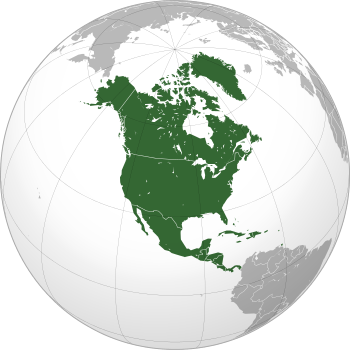
.svg.png)
.svg.png)
.svg.png)
.svg.png)